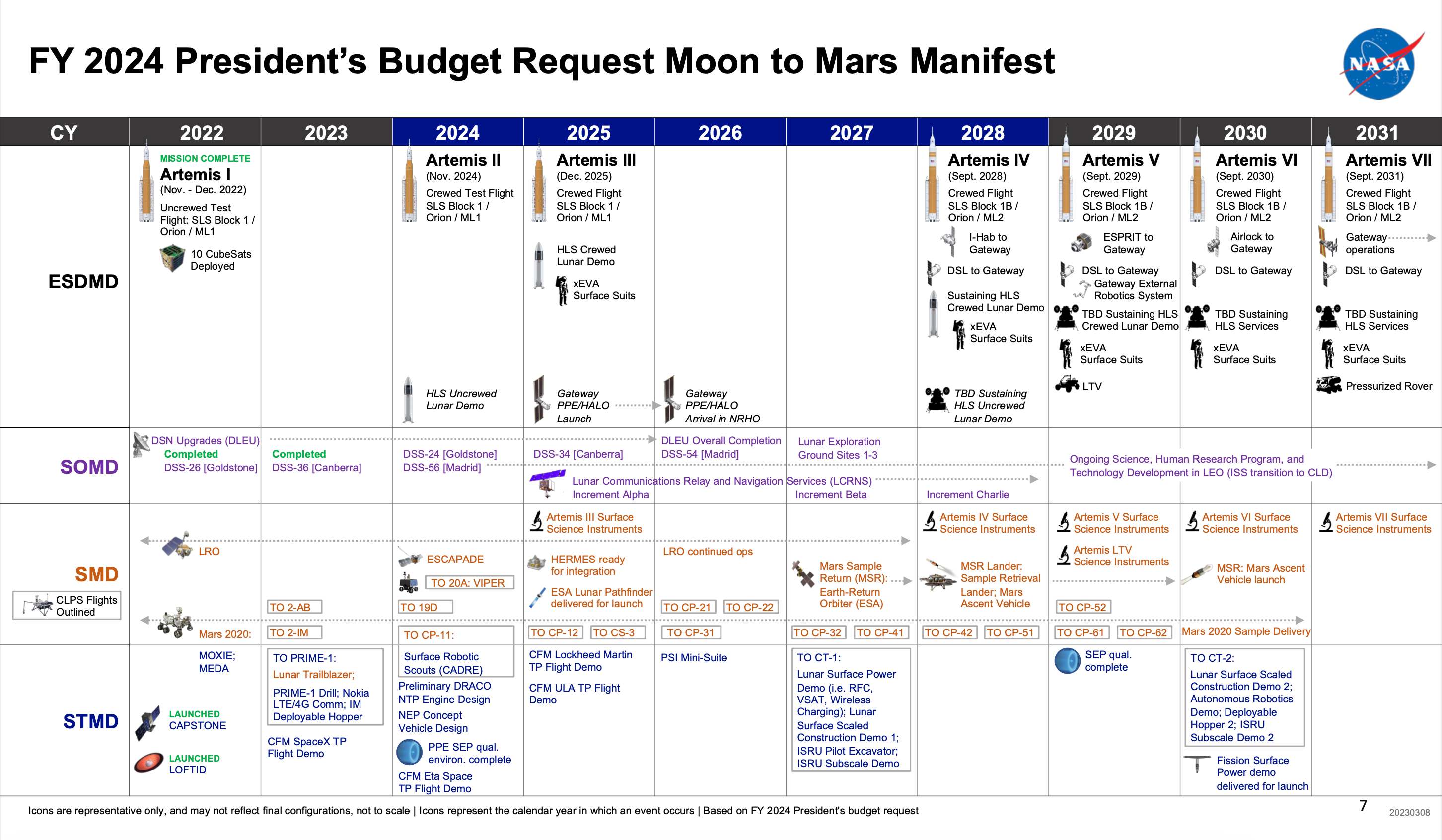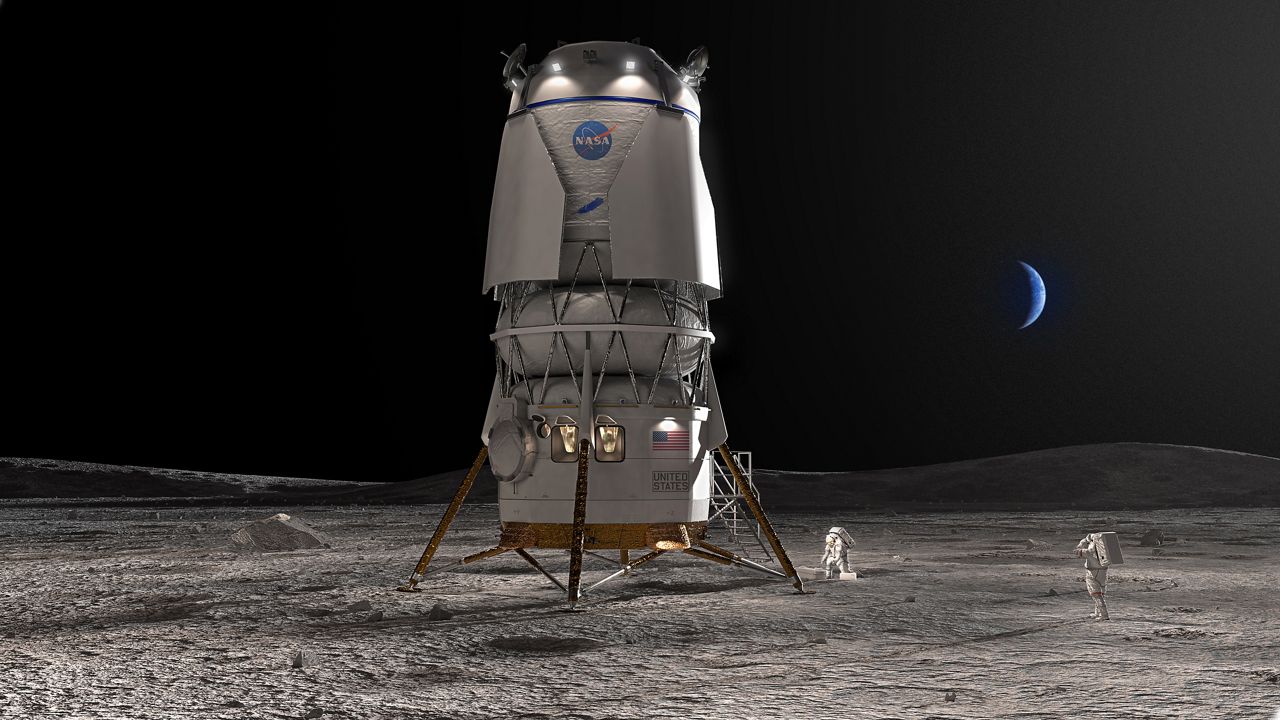CAPE CANAVERAL, Fla. — The Artemis program took another leap forward on Friday as NASA Administrator Bill Nelson announced a team led by Jeff Bezos’ Blue Origin won a contract that will send humans to the Moon on the Artemis V mission.
What You Need To Know
- The most recent water rate increase was drafted in 2018 to cover fiscal years 20190-2022
- Engineering firm Mead & Hunt recommended raising rates by at least 60 percent over the next few years
- Cocoa Beach currently has among the cheapest utility rates in Brevard County
- The Cocoa Beach City Commission will discuss the utility rate study during its regular meeting Thursday evening
The roughly $3.4 billion solicitation ($3,419,345,052.35 to be exact) is part of NASA’s Next Space Technologies for Exploration Partnerships Broad Agency Announcement (Next-STEP2 BAA) and will help fund the Blue Moon lunar lander, a vehicle designed for both crew and cargo missions to the Moon in future years.
The total value of the undertaking will likely be north of $7 billion. John Couluris, Blue Origin’s vice president for lunar transportation, said during Friday’s announcement that Blue Origin and its partners are contributing more than 50 percent of the total cost. When pressed further during the press conference, Couluris didn’t give a specific amount, but said their piece was “well north of $3.4 billion.”
The lander will be fueled by a combination of liquid oxygen (LOX) and liquid hydrogen (LH2), a more sustainable fuel that can be both stored in space as well as created on the Moon using frozen water ice. The company has been working towards perfecting a way to store LH2 in space without losing significant amounts of it due to hydrogen’s low boiling point of -423.2 degrees Fahrenheit (-252.9 degrees Celsius).
“We’re a firm believer in the utilization of hydrogen as being a core, extremely efficient propelling combination for not only lunar exploration, but beyond,” Couluris said. “We’ve been testing not only on the ground, but then we’ll be working with our NASA partnership on their test stand and then continue testing on orbit.”
Couluris added that the 16-meter-tall Blue Moon lander would have two configurations: a reusable version, able to carry up to 20 metric tons, and a one-way configuration that can support up to 30 metric tons.
“[It] allows ourselves, allows NASA, allows the international world to make discoveries on the Moon and adapt where we may want to put those assets,” Couluris said. “As we make new discoveries, as we learn new things, this lander can support growth, if it’s needed.”
Blue Origin beat out a bid from Dynetics, a Leidos-owned company in Huntsville, Alabama, that partnered with Northrop Grumman on its design.
In his formal statement regarding Blue Origin’s selection, Jim Free, NASA’s associate administrator for the Exploration Systems Development Missions Directorate stated, “Dynetics’ proposal does not provide the same value for NASA due to the increased risk associated with its technical approach and less advantageous management approach and price.”
“We’ve been working very hard for this day and we’re looking forward to working together,” Couluris said on Friday.
Blue Origin is leading work on the lander along with its “National Team,” a combination of legacy and new space companies contributing to various parts of the mission. It consists of Lockheed Martin, Draper, Boeing, Astrobotic and Honeybee Robotics.
The Blue Moon lander now joins SpaceX’s Starship in providing the first few landing opportunities of the Artemis program, the first human expeditions to the Moon since Apollo ended more than 50 years ago. Nelson noted the significance of the shift during Friday’s announcement.
“These are public-private partnerships. It’s the new way that we go to the Moon,” Nelson said in his opening remarks. “It helps NASA share the risk, the technical risk and the financial risk, the cost to enable, at the end of the day, mission success.”
Landing astronauts on the Moon is just the beginning of NASA’s Moon to Mars program, which was 1st envisioned by Pres Bush, pushed by Pres Obama, continued by the Trump Admin & has taken flight under @POTUS.
— Bill Nelson (@SenBillNelson) May 19, 2023
Together, we'll pave the way for human missions to Mars in late 2030s. pic.twitter.com/4iKiS9sus1
Blue Moon marks key win for Blue Origin
This latest Human Landing System contract brings Blue Origin into the expanding collection of aerospace companies contributing to the Artemis program. The company was among those that bid for the initial HLS contract, which went to SpaceX in April 2021.
Both Blue Origin and Dynetics pushed back on the $2.89 billion award for the Artemis III mission. 10 days after NASA announced the contract, both companies filed official protests with the U.S. Government Accountability Office (GAO). That forced NASA to halt its contract agreement with SpaceX “until GAO resolves all outstanding litigation related to this procurement.”
After the GAO rejected the lawsuits, Blue Origin took its protest of the single-contract award to the U.S. Court of Federal Claims in August 2021. By November, the court sided with NASA and contract work began in earnest.
In November 2022, NASA modified the contract with SpaceX, called Option B, which added another crewed landing, this time for the Artemis IV mission, set for no earlier than 2028 (originally 2027).
Now, with its own contract award in hand, Blue Origin and its partners will work towards their crewed mission set for 2029. One of the reasons the National Team’s bid was selected was due to its financial investment and additional pathfinding missions.
Free wrote in the selection statement that Blue Origin’s decision to conduct pathfinder lunar missions in 2024 and 2025 that will land on the Moon without crew was a “unique and highly advantageous” way to “mature several critical, low-[Technology Readiness Levels] technologies three years before the Sustaining Lunar Development uncrewed demonstration mission.”
Following those missions, Couluris said on Friday they would also be launching an exact copy of the final version of the crewed lander about a year before the Artemis V mission.
“We will be testing out full lander systems and the full architecture prior to any astronauts entering the vehicle,” Couluris said.
All these missions will also make use of Blue Origin’s forthcoming New Glenn rocket, Couluris said. The rocket has several missions booked on its manifest, but it’s unclear when it will begin launches and what its initial payloads will be.
Spectrum News reached out to Blue Origin following Friday’s announcement, but a spokesperson said, “We don’t have anything further to share about the news today, including New Glenn manifest status, beyond what we have in our public statement.”
Honored to be on this journey with @NASA to land astronauts on the Moon — this time to stay. Together, we’ll be solving the boil-off problem and making LOX-LH2 a storable propellant combination, pushing forward the state of the art for all deep space missions. #Artemis… pic.twitter.com/Y0zDhnp1qX
— Jeff Bezos (@JeffBezos) May 19, 2023
The National Team heads to the Moon
The combination of the National Team’s six principal companies helped solidify its contract award. Dr. Lisa Watson-Morgan, the head of the Human Landing System Program at NASA’s Marshall Space Flight Center, said the agency was “really excited” to work with the National Team.
“We definitely have confidence in them and their approach. They have a very exciting architecture with a reusable Blue Origin lander and Lockheed Martin Cislunar Transporter as well as lots of other contributions from their other partners,” Watson-Morgan said.
Couluris said the members of the National Team have the following roles for the Blue Moon lander:
- Blue Origin – team leader, overseeing lander development
- Lockheed Martin – building Cislunar Transporter (CT) for fueling the lander while in lunar orbit
- Draper – guidance, navigation and control (GN&C)
- Boeing – docking systems
- Astrobotic – cargo accommodations
- Honeybee Robotics (acquired by Blue Origin in 2022) – cargo offloading
In its original design and bid for the Artemis III landing demonstration, Northrop Grumman was part of the National Team and covered the Transfer Element Program, which now seems to be divided between Astrobotic and Honeybee Robotics.
“Congratulation to Blue Origin on this achievement. Lockheed Martin is excited to be part of the Blue Origin’s National team and we are looking forward to building humanity’s first Cislunar Transporter,” said Kirk Shireman, vice president of Lunar Exploration Campaigns at Lockheed Martin Space in a statement. “We value Blue Origin’s thoughtful approach to developing human-rated flight systems and are thrilled to be part of a diverse team that combines innovation, deep experience and a strong industrial base.”
A Lockheed Martin spokesperson told Spectrum News that they will launch a CT for each demonstration mission through the Artemis V mission, but on a separate New Glenn rocket from each of Blue Origin’s landers. That means there will be at least eight New Glenn rockets dedicated to this lunar undertaking.
Artemis competition for exploration
Now that NASA has two contracted lunar landers that can support astronauts, the agency and its partners have options for what missions beyond Artemis V will look like.
Free said during Friday’s announcement that the agency is still working on how it will pick who gets which mission moving forward.
“Our acquisition planning for Artemis VI and out is just getting underway,” Free said. “Obviously, we’ll take advantage of technologies and systems that have already been developed, but we’re just at the forefront for Artemis VI and beyond.”
Despite missing out on selection for the Artemis V mission, a Dynetics spokesperson said they would continue developing its lander:
“Helping NASA with the inspiring efforts to return to the Moon will remain a priority for Leidos. The Artemis missions require multiple partners to achieve success, and our Leidos-Dynetics team is committed to continuing to assist on these critical missions. We are proud of the great progress on our current work with NASA, such as designing and developing the Universal Stage Adapter for the Space Launch System and delivery of laser air monitoring systems for Orion, along with working to design a Lunar Terrain Vehicle. We have a strong history of leveraging our technical expertise to support the International Space Station, NASA missions and the NASA enterprise. Leidos will remain focused on developing advanced technologies and innovations to enable safe and sustainable exploration and discovery to the Moon and beyond.”
We’ll have to watch and see if everything remains on time as SpaceX and Blue Origin push forward with their respective landers, but here’s what the current, planned timeline looks like, according to both the FY24 NASA budget request and the new announcement from Blue Origin:
- 2024 – Starship uncrewed lunar demo
- 2024 – Blue Moon uncrewed lunar demo
- 2025 – Blue Moon uncrewed lunar demo
- Dec. 2025 – Starship crewed lunar demo (Artemis III)
- 2028 – Blue Moon uncrewed lunar demo (using copy of final crewed lander)
- Sept. 2028 – Starship crewed lunar demo (Artemis IV)
- Sept. 2029 – Blue Moon crewed lunar demo (Artemis V)




